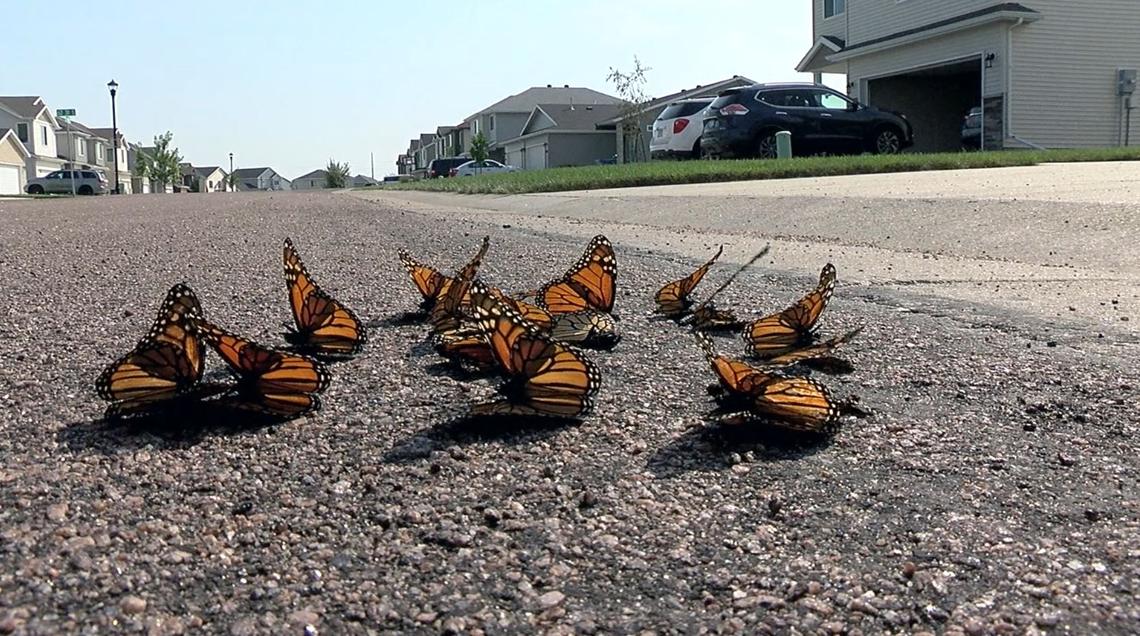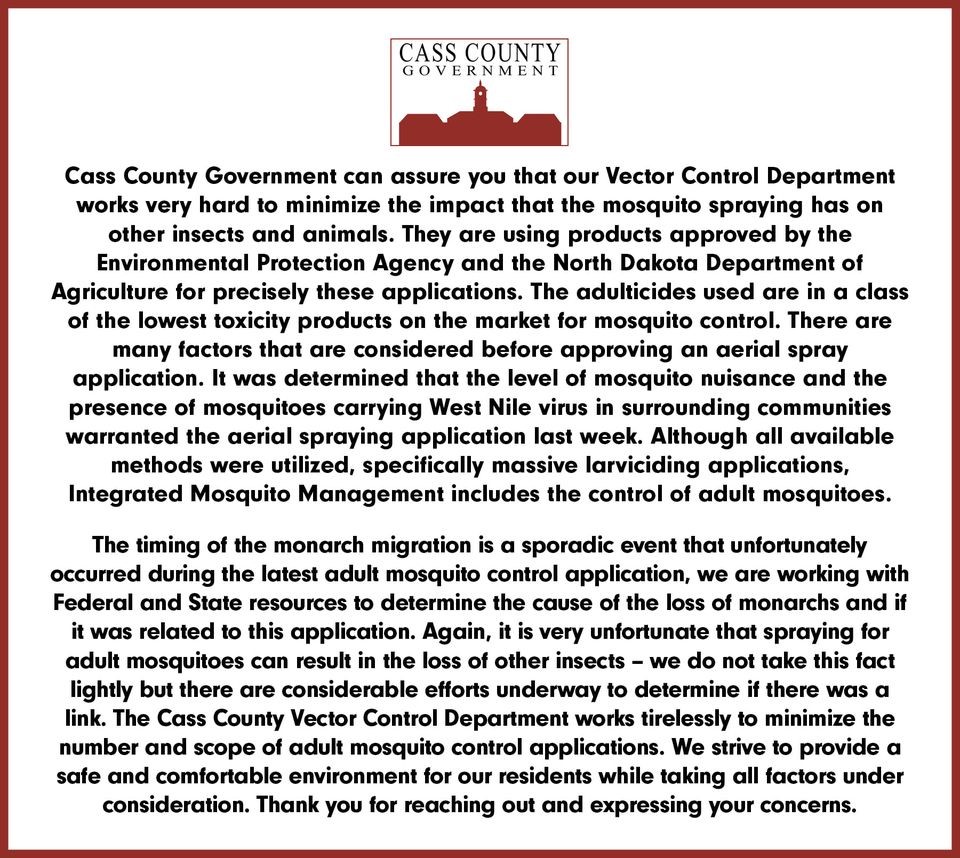02
Sep
Monarch Massacre: Hundreds of Monarch Butterflies Die After Aerial Mosquito Spraying in North Dakota
 (Beyond Pesticides, September 2, 2020) It’s being called the Monarch Massacre—hundreds of monarch butterflies found dead after the Vector Control Department of Cass County, North Dakota aerially sprayed the county for mosquito control. This incident occurred during a moment in history that is seeing monarchs at the edge of extinction, with the number of monarch butterflies overwintering in Mexico having declined 53% from last year, according to a count conducted by World Wildlife Fund (WWF) Mexico. This tragedy happened as the nation and the world are experiencing an insect apocalypse and severe biodiversity decline, threatening the web of life. (See Study Predicts Demise of Insects within Decades if Pesticide Dependence Continues.)
(Beyond Pesticides, September 2, 2020) It’s being called the Monarch Massacre—hundreds of monarch butterflies found dead after the Vector Control Department of Cass County, North Dakota aerially sprayed the county for mosquito control. This incident occurred during a moment in history that is seeing monarchs at the edge of extinction, with the number of monarch butterflies overwintering in Mexico having declined 53% from last year, according to a count conducted by World Wildlife Fund (WWF) Mexico. This tragedy happened as the nation and the world are experiencing an insect apocalypse and severe biodiversity decline, threatening the web of life. (See Study Predicts Demise of Insects within Decades if Pesticide Dependence Continues.)
While it is critical that steps be taken by communities nationwide to protect their local ecology, the incident generated a response from Cass County that claims that the insecticides used are “the lowest toxicity products on the market for mosquito control,” and points to the “monarch migration [that] is a sporadic event that unfortunately occurred during the latest adult mosquito control application.”
The County justifies the spraying because of nuisance mosquitoes and a finding in the “surrounding communities” of mosquitoes carrying West Nile virus (WNv). In its Facebook statement, the County provides no monitoring data for WNv, does not disclose the threshold levels of insect borne disease, and fails to identify any risk to human and environmental health from its pesticide use. Instead, the agency refers to “lowest toxicity” products, claims made by chemical manufacturers but not verified by the independent scientific literature. In fact, the Vector Control Department’s website indicates that it is using the highly toxic insecticide permethrin, a synthetic pyrethroid linked to neurotoxicity and cancer. The Department states on its website:
“Cass County uses a number of synthetic pyrethroids to control adult mosquitoes. Pyrethroids are synthetic chemical insecticides that act in a similar manner to pyrethrins, which are derived from chrysanthemum flowers. Pyrethroids are widely used for controlling various organisms including head lice. Permethrin, bifenthrin, and etofenprox, are synthetic pyrethroids commonly used in mosquito control programs to kill adult mosquitoes.” (See County website.)
Clearly the Department is downplaying the toxic nature of the chemicals that it uses. As stated, the pesticides being used by the county are synthetic pyrethroids not natural chemicals “derived from chrysanthemum flowers,” known as pyrethrums. Like other communities, Cass County mosquito management relies solely on U.S. Environmental Protection Agency (EPA) pesticide registration, which is disputed by independent science, and its own history of past pesticide use to justify continued pesticide use—without any reference to the controversy associated with synthetic pyrethroid use captured in the scientific literature. In an effort to reduce its characterization of hazards associated with the mosquito pesticides, the Department points to its use of ultra low volume (ULV) applications to downplay concerns about public exposure. To further justify widespread and indiscriminate use of synthetic pyrethroids for mosquito control, the county website cites other widespread uses of these pesticides, including “household insect foggers; ant and other insect sprays for the home; tick and flea sprays; flea dips & sprays; collars for cats and dogs; termite treatments; agricultural and livestock products; [and] for the treatment of head and body lice.”

Beyond Pesticides has noted that exposure to synthetic pyrethoids exacerbates the very threats associated with coronavirus. In effect, the use of these chemicals and public exposure increase the risk factors associated with Covid-19. (See Beyond Pesticides webpage and factsheet.)
Context is critical to the threat that monarchs are suffering. WWF’s monarch count found that monarchs occupied seven acres this winter, down from 15 acres last year. Reports indicate that 15 acres is a minimum threshold needed to prevent a collapse of the butterfly’s migration and possible extinction.
The threat to ecosystems from widespread spraying for mosquito management made national news when over two million bees killed after aerial mosquito spraying in South Carolina in 2016. Smaller wildlife kills often go unreported in the news.
Because monarchs are under threat, mosquito spraying adds considerably to the species decline. Recent research finds that western monarch milkweed habitat contains a “ubiquity of pesticides” that are likely contributing to the decline of the iconic species. The research, published in Frontiers in Ecology and Evolution, provides a grim snapshot of a world awash in pesticides, and raises new questions about the U.S. regulatory process that continues to allow these toxic chemicals on to the market without adequate review and oversight. (See Milkweed in Western Monarch Habitat Found to be Completely Contaminated with Pesticides)
Tell Public Officials to Stop Mosquito Spraying and Adopt a Safe, Effective Mosquito Management Plan.
For information on ecological based mosquito management, see Beyond Pesticides Safer Mosquito Management page. Also, see Public Health Mosquito Management Strategy for Decision Makers and Communities.
All unattributed positions and opinions in this piece are those of Beyond Pesticides.
Source: https://www.facebook.com/CassCountyGovND/











Quit taking advice from the vendors that sell insecticides. They use fear as a way of selling their product. Put some bug spray on if you’re afraid to go outside because there could be a mosquito. Over NINETY percent of birds eat mosquitoes. They need an abundance. Insecticide sprays are not selective to mosquitoes. They kill insects along with other wildlife. BEES are killed too!
September 4th, 2020 at 2:59 am